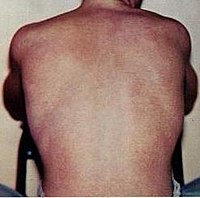
Photo from wikipedia
Objective Dengue fever is one of the most important arboviral diseases in the world, and its severe forms are characterised by a broad spectrum of systemic and cardiovascular hallmarks. However,… Click to show full abstract
Objective Dengue fever is one of the most important arboviral diseases in the world, and its severe forms are characterised by a broad spectrum of systemic and cardiovascular hallmarks. However, much remains to be elucidated regarding the pathogenesis triggered by Dengue virus (DENV) in the heart. Herein, we evaluated the cardiac outcomes unleashed by DENV infection and the possible mechanisms associated with these effects. Methods A model of an adapted DENV-3 strain was used to infect male BALB/c mice to assess haemodynamic measurements and the functional, electrophysiological, inflammatory and oxidative parameters in the heart. Results DENV-3 infection resulted in increased systemic inflammation and vascular permeability with consequent reduction of systolic blood pressure and increase in heart rate. These changes were accompanied by a decrease in the cardiac output and stroke volume, with a reduction trend in the left ventricular end-systolic and end-diastolic diameters and volumes. Also, there was a reduction trend in the calcium current density in the ventricular cardiomyocytes of DENV-3 infected mice. Indeed, DENV-3 infection led to leucocyte infiltration and production of inflammatory mediators in the heart, causing pericarditis and myocarditis. Moreover, increased reactive oxygen species generation and lipoperoxidation were also verified in the cardiac tissue of DENV-3 infected mice. Conclusions DENV-3 infection induced a marked cardiac dysfunction, which may be associated with inflammation, oxidative stress and electrophysiological changes in the heart. These findings provide new cardiac insights into the mechanisms involved in the pathogenesis triggered by DENV, contributing to the research of new therapeutic targets for clinical practice.
Journal Title: Heart
Year Published: 2021
Link to full text (if available)
Share on Social Media: Sign Up to like & get
recommendations!